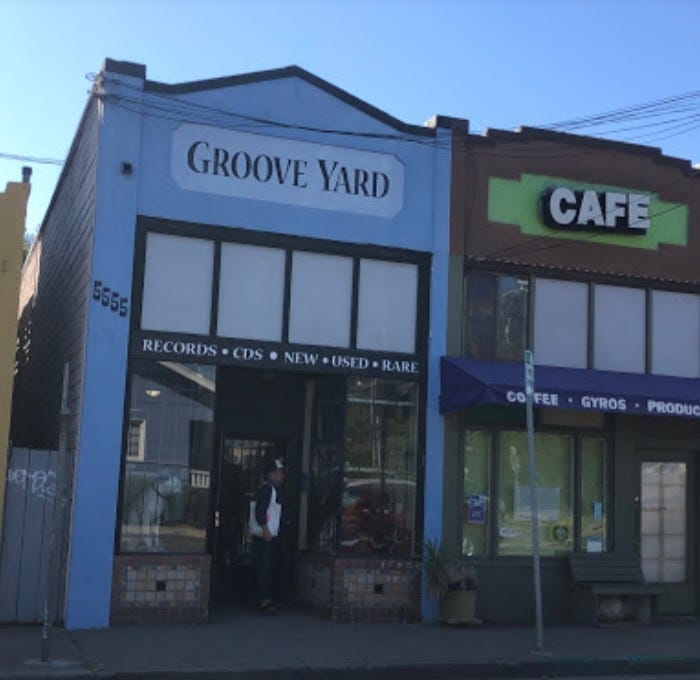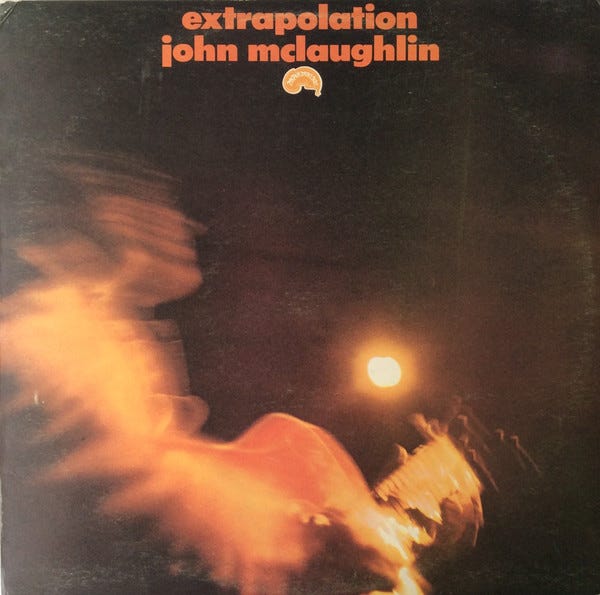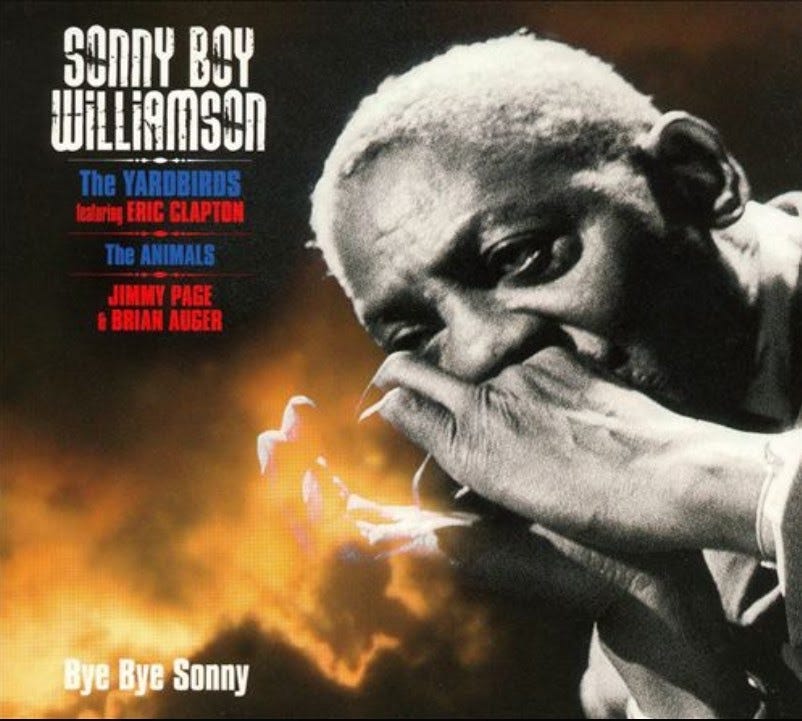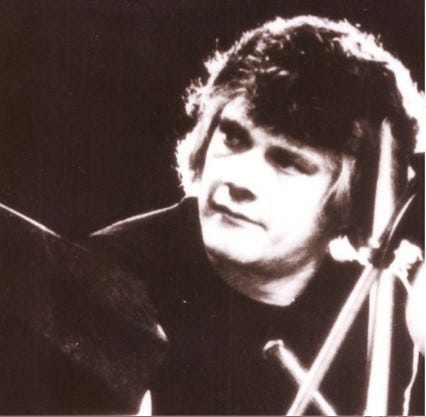On a beautiful weekend afternoon in a neighborhood on the Berkeley/Oakland border, I found myself strolling with friends after a lovely meal at a nearby restaurant. As we chatted and window shopped I was soon distracted by a store I glanced at across the street.
Groove Yard, it said. Used records. I soon lost track of the conversation, but resisted the urge to bolt from my friends. We were having such a great time I just wanted to enjoy their company. To my delight they decided to continue the window shopping across the street. As we approached the record shop they decided to enter a nearby store. I slipped away and dove into Groove Yard to have a quick look before they moved on. This was my first time in this shop although it had clearly been around for years. One of the first things I noticed was a record prominently displayed on the wall just above the bins. $140 bucks. It wasn’t the price that surprised me. It was the fact that I have that record in my collection. After the brief shot of excitement at this windfall, I was simply reminded of how old I am. I moved to the bins closer to the store front window so I could see my friends passing by. Immediately I pulled out a record by John McLaughlin called “Extrapolation”. I turned it over to skim the liner notes, and there it was … “Produced by Giorgio Gomelsky.” I could hardly believe my eyes. I’d learned about Gomelsky just a few months prior and was shocked to find his name all over my record collection. This McLaughlin record was not in my collection. But it is now.
“Extrapolation” is the very first solo record by John McLaughlin. Gomelsky booked studio time for John in January of 1969 at Advision Studios in London. John brought in some of the guys he’d been playing with in the London jazz scene. After a few rehearsal sessions to learn John’s songs, they knocked out the recording in about a day. The engineer for the session was a young guy that Gomelsky had worked with before. His name is Eddy Offord and he would soon go on to help create some of the greatest albums of the classic prog rock period of the early 70’s, including those by YES and ELP. McLaughlin’s career would also accelerate rapidly after this recording.
Gomelsky would release “Extrapolation” on his label Marmalade through a distribution deal he had worked out with Polydor Records. Here’s what he said on the liner notes:
“As knowledge and experience of musical forms increase attention will direct itself more and more at 'real' musical issues rather than 'fashionable' ones. At the time of writing the situation has already arisen, as witnessed by the popular acclaim deservedly showered upon such groups as Blood, Sweat & Tears. Johnny McLaughlin, hailed by many critics as a face to watch in '69 has made this LP with John Surman, Tony Oxley and Brian Odges (sic), three of the best young British Jazz musicians of today. It is a mere formality that talents such as these will be at the forefront of another challenging period of musical taste evolution.”
When this album was released in 1969, McLaughlin was little known outside of the London jazz club circuit. Even that scene had been giving way to the R&B clubs, one of which was owned by Gomelsky from 1963 to 1965 called The Crawdaddy Club. He briefly got the Rolling Stones going, but it was the Yardbirds that put his club on the map, and himself in the rolodexes of the record company execs. Gomelsky seemed to know everybody in the London music scene and he soon had a stable of talent to work with. The first recordings he did in 1963/64 were with American blues legend Sonny Boy Williamson. Gomelsky played host to Sonny Boy for several weeks, recording him with The Yardbirds, The Animals, and Brian Auger with Jimmy Page.
Page and Auger were well known in the close knit community of London studio session musicians where they would often cross paths with or even be in the same session as John McLaughlin (see list below). Page even took a few lessons from McLaughlin prior to their session days when John worked in the Selmer music store playing all their guitars on the slow days. The place was as much social center as music store, and when Jimmy saw John playing he knew right away he was looking at the best.
By the late 60’s both rock and jazz were headed in new directions … rock into the psychedelic and jazz into free improvisation. “Extrapolation” would dip it’s toes into the latter, but it was still mostly composed by McLaughlin. While the sax player Surman found the works challenging and exciting, free jazz purist drummer Tony Oxley called it a pop record. Even the music critics were very mixed in their response, one calling McLaughlin the greatest guitarist of the day, with another complaining about too many notes. Suffice it to say that the album didn’t create much buzz when it was first released, and everyone involved seemed to move on to other things.
After recording “Extrapolation” in January, an invitation by former Miles Davis drummer Tony Williams brought McLaughlin to America in February of 1969, and on the 18th of the month he was recording “In a Silent Way” with Miles. The month of May would have him in the studio with The Tony Williams Lifetime band. And in August he’s recording “Bitches Brew”. Soon after that he hit the road with Miles, and somewhere along the way Miles tells him he should start his own band. To John this was not merely a suggestion, this was a commandment from on high. “I had to do it, if just to justify his belief in me.” He was soon asked to join the band Weather Report, but he had to tell them “wow, that’s great, but I’m under orders!” The Mahavishnu Orchestra would release their debut studio album “The Inner Mounting Flame” in August of 1971.
Marmalade Records would come to an end in 1970 releasing several albums by Julie Driscoll and Brian Auger before it was over. Brian was the one who suggested to Giorgio that he record McLaughlin. Other Marmalade jazz albums included ‘John Stevens Spontaneous Music Ensemble’, also released in 1969 and also engineered by Eddy Offord. In 1970 Gomelsky would produce ‘The Keith Tippett Group – You Are Here... I Am There’ for Polydor Records (again engineered by Offord). You might remember Tippett from his contribution to early King Crimson albums. Tippett would later marry and record with Julie Driscoll. These two would contribute volumes to the avant jazz scene all over Europe. I would have the good fortune to see Keith play solo in Berlin in 1989.
This music that I’d come to love over the decades was always pointing a finger at this one man, Gomelsky.
Giorgio Gomelsky died in 2016 and I still wouldn’t know his name until over a year later.
In early 2020 I was listening to an audio interview with John McLaughlin. By then I was deep into my research for the book “The Gomelsky Recordings”, so I became riveted to what I was hearing when he started talking about his early recordings. When asked about “Extrapolation” he only made a few oblique comments …
"the album was a total experiment"
"would have been nice to get paid"
"unsavory people everywhere"
He didn’t mention any names, but could he be talking about Gomelsky? I thought it was worth trying to ask him myself, so I sent him an email and waited. A week went by without a response. Then it came. John McLaughlin was very polite and to the point. In short, Gomelsky had stiffed him and he didn’t want to talk to me about him. As mentioned above, the album was originally released on Gomelsky’s Marmalade label. Those sales were meager at best. However, after Mahavishnu exploded onto the scene in 1971, the “Extrapolation” album was reissued -- this time on the Polydor label. Those sales were presumably much better. In between those two releases, Marmalade went bankrupt and I’m pretty sure Gomelsky severed his ties to Polydor as a result of that. So who owned the rights to “Extrapolation” in 1972? And who would have been responsible for distributing royalties to John McLaughlin? I don’t know the answer to these questions but you can be sure I will be digging into that for the book. John’s response is completely understandable. He saw himself as a naive young artist who got taken advantage of. Unfortunately, it’s an old story in the music business (and elsewhere of course). He’s not the first one to express this animosity toward Gomelsky. The Yardbirds parted ways with him for much the same reason. Show me the money!?
This period from 1969 to 1972 saw big changes for all of them. Both John McLaughlin and Jimmy Page would of course become superstars with their own bands. Gomelsky would continue to work in London for a while, even doing some recordings with the original members of Soft Machine. Co-founder Daevid Allen would find himself stranded by visa problems in France. After Marmalade went south, Gomelsky decided to join him there and help him with his new band Gong. They soon had a viable touring network set up all over France that would help many European avant bands, including Magma (who Gomelsky would end up producing), Henry Cow, and others. Out of this network would spring the Rock In Opposition movement that would help record, release and promote the most outside of the avant bands. But for Gomelsky, all roads were now pointing to New York. By the end of the 70’s he would relocate there, hook up with a young Bill Laswell and form the band Material. And that, my friends, is a story or two for another blog post.
Seven Sessions with Page
This list comes from the book and web site ‘Bathed in Lightning’ by author Colin Harper.
Andrew Oldham Orchestra; 16 Hip Hits (Ace Of Clubs ACL 1180); Recorded: Regent Sound Studios and Decca Studios, London, July and/or September 1964; Released: October 2 1964
Paul Anka; To Wait For Love/Behind My Smile (RCA 1434); Recorded: ?/64; Released: January 1965
Dionne Warwick; The Sensitive Sound of Dionne Warwick (Pye International NPL 28055); Recorded: November 1964 (during UK tour); Released: February 1965; Prod: Burt Bacharach & Hal David; Le London All Star [sic]; British Percussion (Barclay BB 86); Recorded: Pye Studios, London, February 23 1965; Released: September 1965 (France)
Vashti [Bunyan]; Some Things Just Stick In Your Mind / I Want To Be Alone (Decca F 12157); Recorded: ?/65; Released: May 21 1965
The Hairy Ones; Get Off My Cloud (EP) Barclay 70898; Get Off My Cloud / It’s My Life / Gloria / Ring Dang Do; Recorded: ?1965; Released: 1965 (France)
Twice As Much; Own Up (Immediate IMLP 007); Prod: Andrew Loog Oldham; Recorded: London, July 1966; Released: 1966
Biddu; Daughter Of Love / Look Out Here I Come (Regal Zonophone RZ 3002); Recorded: Advision Studios, London ?/67; Released: September 15 1967; Prod: Tony Visconti; Biddu - vocals; Nicky Hopkins - piano; John McLaughlin, Jimmy Page - guitars; John Paul Jones - bass guitar











Yes, there are indeed two sides of that story which, unfortunately, seem to haunt Giorgio's life. I've known Giorgio in abject poverty as well as in some better times, and there are also two sides that repeat themselves throughout his life.
Gomelsky deserves to have that book about him because of his interaction with so many great musician/composers.